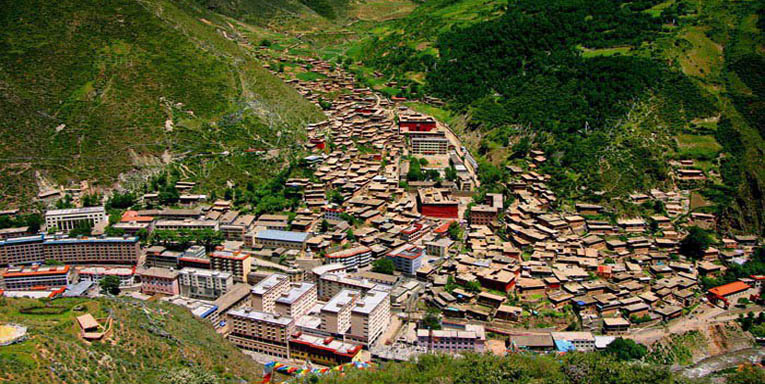Descendant of Lodro Gyatso lineage
 1678-1738), the fifth abbot of Lhundrubteng (hun grub steng) and the king of the Dege kingdom. His brother Puntsok Tenpa (phun tshogs bstan pa, d.1751) served as the sixth abbot of Lhundrubteng, also known as Dege Gonchen (sde dge dgon chen), as well as king of Dege, after their father passed away. He had at least one sister,Yangchen Dolma (dbyangs can sgrol ma, d.1786).
1678-1738), the fifth abbot of Lhundrubteng (hun grub steng) and the king of the Dege kingdom. His brother Puntsok Tenpa (phun tshogs bstan pa, d.1751) served as the sixth abbot of Lhundrubteng, also known as Dege Gonchen (sde dge dgon chen), as well as king of Dege, after their father passed away. He had at least one sister,Yangchen Dolma (dbyangs can sgrol ma, d.1786).
As a younger son he ordained in his youth, joining Lhundrubteng for his monastic education. It was customary for abbots of Ngor Ewam Choden (ngor e waM chos ldan), a major Sakya monastery in central Tibet, to spend several years in Dege and serve as court chaplain. Among the Ngor abbots from whom Lodro Gyatso received teachings were Pelden Chokyong (dpal ldan chos skyong, 1702-1760), the thirty-fourth abbot of Ngor; Jampa Namkha Samdrub (byams pa nam mkha’ bsam grub, 1696-1754), the thirty-third abbot of Ngor; and Sharchen Mingyur Gyeltsen(shar chen mi ‘gyur rgyal mtshan, b.1717), the thirty-seventh abbot of Ngor.
He trained with many other Dege-based lamas, including Situ Paṇchen Chokyi Jungne (si tu 08 chos kyi ‘byung gnas, 1699/1700-1774); Tsultrim Rinchen (tshul khrims rin chen, 1697-1774), the main editor of the Dege Tengyur (sde dge bstan ‘gyur); the Second Dzogchen Drubwang, Gyurme Tekchok Tendzin (rdzogs chen 02 ‘gyur med theg mchog bstan ‘dzin, 1699-1758); and Drime Zhingkyong Gonpo (dri med zhing skyong mgon po, b.1724).
He traveled to central Tibet where to visited the major Sakya monasteries of Sakya(sa skya) and Ngor, and received teachings from the Thirty-second Sakya Tridzin, Kunga Lodro (sa skya khri chen 32 kun dga’ blo gros, 1729-1783).
He is said to have trained well in medicine and to have practiced.
In 1739, when his brother, then the abbot of Lhundrubteng, was in Tibet, he served as a replacement. Following his brother’s death in 1751 he was enthroned as the seventh abbot of the monastery.
According to local histories, in 1755 a territorial conflict erupted between the noble family of Trehor Khangsar (tre hor khang gsar), which was supported by Dege, and the Mazur family (ma zur), which had support of the Trokyab Ponpo (khro skyabs dpon po) in Gyarong (rgyal rong). The Mazur was ordered by the Ganden Podrang government in Lhasa, but they refused the command and attacked. Lodro Gyatso sent an army from Dege and successfully repelled the incursion, destroying the Mazur and killing the Trokyab Ponpo.
Lodro Gyatso married a niece of Seventh Dalai Lama, Kelzang Gyatso (ta la’i bla ma 07 bskal bzang rgya mtsho, 1708-1757) named Tashi Wangmo (bkra shis dbang mo). She gave birth to Sawang Zangpo (sa dbang bzang po) in 1766.
During his reign, Lodro Gyatso continued to sponsor the carving of the wooden matrices and printing of various Tibetan academic compositions, and also sponsored of temple restoration works at various monastic institutions in Dege.
During the winter of 1771-1772 the Thirteenth Karmapa, Dudul Dorje (karma pa 13 bdud ‘dul rdo rje, 1733-1797), resided at Situ Panchen’s seat, Pelpung (dpal spung), where Lodro Gyatso visited him. In 1773, when fighting again broke out in Gyarong, Lodro Gyatso requested Situ Paṇchen to travel to the region and mediate. Despite his ill health and advanced age, Situ Penchen agreed, but never arrived in the region, passing away in Golok in 1774.
Lodro Gyatso himself passed away in 1779, at the age of fifty-two. His sister Yangchen Dolma took the throne following his death, while his son Sawang Zangpo was a minor.
Source: The Treasury of lives
Leave a Reply